
 |
|||||
|
|
|||||
|
|
|
|
||||||||||
|
|
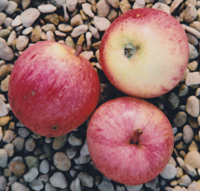 |
ETHELBERT OAKENFULL A beautiful apple, first brought to our notice in 2012 when Michael Clark, of Tewin Orchard, asked us to graft new trees on behalf of a friend, Peter Oakenfull, a Naturalist. His father, Mr Ethelbert Oakenfull (known as Bert) found a 4-foot sapling growing at a disused Italian POW camp at Hatfield Hyde, Welwyn Garden City, Hertfordshire, in 1956. The old World War II Nissen Huts were being used by Murphy Radios, where Bert was a french polisher. There were two saplings growing close to each other in the overgrown verge of a hedgerow. Bert and a friend took one each and Bert’s was planted in his back garden at Green Acres, Welwyn Garden City, about a mile away and where it still grows today. Bert took great pride in his tree and regularly distributed the abundant fruit to friends and work colleagues. In 2011, when Bert was 91, he wanted his ageing tree to survive into the future and asked his son, Peter, if he would arrange for new trees to be grafted. Peter took cuttings to his friend, Michael Clark, who asked us to graft them. The new trees were delivered in autumn 2013, though Bert had passed away, before he was able to enjoy the acclaim his apple was receiving, but in the certainty that his very special tree would live on. It is a medium sized, round to tapering oblong eating apple, which has also been used for juicing and makes a good apple for baking in tarts, where it keeps its shape when sliced and cooked. The smooth, clean skin has a base colour of cream, beautifully flecked and streaked with pink and carmine. It is usually ripe from mid-September to mid-October, and will stay in good condition, often hanging on the tree into December in late ripening years. The flesh is very crisp, fine, juicy and sweet. It has the added attraction that it usually forms fruiting spurs in its first year and will fruit in its second year. Thereafter, the crops are abundant. An excellent apple. Pollination Group 4 |
||
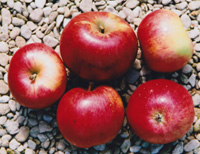 |
EVE APPLE The historic literature records Eve, Eve Apple, Eve’s Apple, Eve’s and Eve Apple (of the Irish) but the many descriptions are inconsistent and do not allow the confident and correct placement of the apple we have here with any of them. Nonetheless, it could be any of them. We have had this apple, named Eve Apple, here for many years and have enjoyed its fruit while considering which name is correctly applied. We obtained it from the collection of the late Nick Botner in Oregon. There is not enough space here to list all the old references and their descriptions but there is one that completely fits this apple. John Robertson was a famed nurseryman and pomologist of Kilkenny from the early 19th century. In 1819 he sent a list with descriptions to the Secretary of the London Horticultural Society of various apples known by him in Ireland. Later, in 1831, he sent a list of “such apples as have been found to succeed in the Neighbourhood of Kilkenny in Ireland” to Loudon’s ‘Gardeners’ Magazine’. He described a ‘Scarlet Eve’ in 1831 as follows. “ Scarlet Eve (Early Margaret of the London Hort. Soc. Catalogue). – A middle-sized oval fruit, flattish at the eye and stalk. Eye shallow and wrinkled. Stalk short, inserted in a shallow cavity. Sides slightly angular. Ground colour when ripe, a yellowsh green in the shade, to the sun a bright crimson marked with darker streaks and some russet about the stalk. Flesh whitish, sometimes tinted with red next the skin; crisp and juicy; flavour saccharine, pleasantly acidulated, and accompanied by a perfumed odour. Ripe the earlier part of August. Tree is middle-sized, grows erect, and bears well. One of the earliest, and the best apple of the season; we reckoned it an Irish fruit, but it has been so long and universally known, that its origin is doubtful.” This description might also fit, to some degree, other descriptions of Eve Apple etc., but we leave the matter open. It is a very attractive medium sized (sometimes larger) apple, ripe in mid to late August, and only lasting for a few weeks. The flesh is crunchy and crisp, very juicy, very sweet and with a rich flavour for an early apple. The glossy skin is very brightly streaked and blushed with red. Pollination Group 3 |
|||
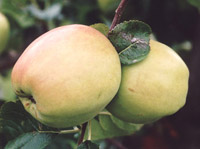 |
EYNSHAM
CHALLENGER A large culinary apple attributed to Frederick William
Wastie, fruit breeder and nurseryman at Eynsham in Oxfordshire, and raised
from Blenheim Orange x Lord Derby in 1935. In that year, he was 77 years
old and it is more likely that the apple was raised by his son James Frederick
Wastie who was then breeding his own fruits and who was also responsible
for naming his father’s fruits, later. It was exhibited at the RHS
in 1959 by James Frederick Wastie (according to family records) and later
entered the National Fruit Trials. The apple is ribbed, rounded and oblong
to conical, with pale yellow-green skin, slightly flushed with orange
and lightly russeted. The apples are ripe quite late in the season and
will last until the year end. When cooked, the flesh breaks down to a
sharp but fairly rich purée. It crops well. Pollination Group 4 |
|||
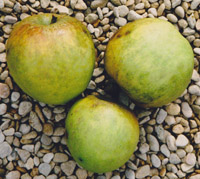 |
EYNSHAM
DUMPLING Raised in 1935 from the seed of Blenheim Orange pollinated
by Sandringham, and attributed to Frederick William Wastie but possibly
the work of his son, James Frederick Wastie, who took over his father’s
nursery at Eynsham, Oxfordshire, and continued to breed fruits. F.W. Wastie
was 78 years old in 1935. It was exhibited at the RHS by James Frederick
Wastie in 1958. He was also responsible for naming his father’s
apples. It was received by the National Fruit Trials in 1960 and is still
in the National Collection. A medium to large culinary apple, ripe quite
late in the season and lasting to the year end. The ribbed apples are
conical to squarish, with yellow-green skin, thinly covered with russet,
and occasional patches, and with a warm glow in the sun. The flesh is
sharp and firm, which when cooked keeps its shape with a reasonably good
sweet-sharp flavour, though the addition of a little sugar helps. The
trees are very productive, regular croppers and yield apples of uniform
size and shape. The blossom is large and attractive. Pollination Group
4 |
|||
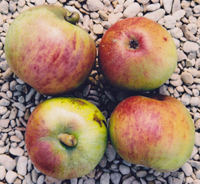 |
FAIR
MAID OF DEVON An old Devonshire cider apple, first recorded in
1934, when it was exhibited from Devon at the Apple and Pear Conference
at Wisley, but it is much older. It was described as being a cider ‘sharp’,
middle season, medium sized, round and striped. It has been known since
and it has fruited here for several years. It is an attractive apple and
a reliable and fairly precocious cropper, which could certainly be considered
a cider sharp in late September, with a fair amount of tannin, but in
October the harshness fades and it becomes a pleasant, juicy, sweet, rich
and melting eating apple, with only modest sharpness. It is also good
for cooking, keeping its shape and developing a rich floral flavour –
sweet enough, though some might want to add sugar.The early tannin that
assists in cider making has now faded to negligible levels. The apples
last well, to the end of the year, sometimes beyond. Pollination Group
4 |
|||
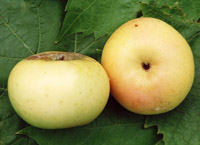 |
FALLBARROW
FAVOURITE Though believed to be much older, it was first recorded
in 1936 and seemed to have disappeared after Taylor wrote about it in
‘The Apples of England’ in 1936 and 1946. It was rediscovered
in the orchard of Mr Gibson at Tarnside, near Crosthwaite, Westmorland
(Cumbria), by Hilary Wilson, who sent us scions in 2001. It is a flattened,
medium sized, yellow-green apple with a warm amber to red flush, used
as a middle season cooker, ripe in September. It breaks down when cooked,
but not quite to a purée. The flavour is rich, mellow and slightly
tangy. It is sweetish, but sugar might be wanting. The apples do not store
for long in the south and tend to be rather variable in shape and colour
from year to year. By mid November they are still reasonably firm, but
the flavour starts to fade. Taylor says it is small, of the codlin type
and angular, though we find this apple is only slightly ribbed and only
small in poor years. Pollination Group 5 |
|||
FAMEUSE
An old and much favoured apple that probably arose in Canada, though the
earliest reference seems to be in the USA where it was much planted around
1730. It became known in Britain around 1800. Forsyth described it as
‘a pretty large Apple, of a beautiful dark red, with a little yellow
on the side from the sun. The flesh is very white, and full of a rich
sugary juice; and it comes into eating about the latter end of October.
This Apple was introduced from Canada, by Mr. Barclay, of Brompton, Middlesex’.
Scott describes the flesh as very white, very tender and delicate, with
a nicely perfumed juice, one of our most beautiful apples. He thought
it likely that it was brought to Canada by French settlers since so many
of its synonyms are French. The tree is small, but gives good crops. It
has also been highly regarded for cooking and cider. Pollination Group
3 |
||||
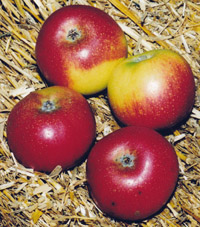 |
FEARN'S
PIPPIN A very good, late dessert apple known since about 1780.
Bunyard attributes it to Mr Bagley of Fulham, Middlesex. A bright scarlet
fruit, with crisp, juicy flesh and a sweet lemon taste. Small to medium
sized. Very popular around London in the mid nineteenth century. Ripe
in October, it will keep until February. A good cropper. Pollination Group
4 |
|||
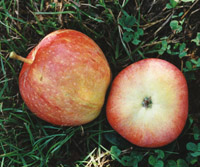 |
FELTHAM
BEAUTY A colourful, very early dessert apple, raised by Veitch’s
Nursery at Langley, Buckinghamshire in 1908. It was a cross between Cox’s
Orange Pippin and Gladstone. The apples have sweet, firm, juicy flesh,
and are best eaten soon after picking in August. They do not last long
into September. Trees have attractive blossom, striped pale pink. Pollination
Group 4 |
|||
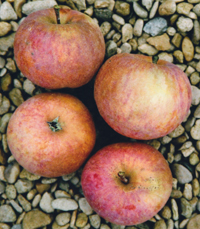 |
FENOUILLET
GRIS An old apple first recorded in 1608 when described as Espice
D’Hiver, listed by Olivier de Serre. It was in the London Horticultural
Society catalogue of 1826. There has been some confusion between this
and Caraway Russet, starting with Lindley in the 1830s, and not entirely
resolved. The word Fenouillet means fennel, of which the apple’s
flavour is said to be reminiscent. It is a dessert apple but has also
been used for cider. Scott in 1872 describes it as medium sized, in season
February to March, roundish ovate, but broadest at the base. The skin
is golden yellow nearly covered with brown russet, with a greyish brown
tinge on the sunny side. The flesh is yellowish, rich, tender, crisp and
sugary with a fine aromatic flavour. It can go woolly if kept too long.
The tree is a slender grower, but good bearer in warm soils. Pollination
Group 4 |
|||
|
||||